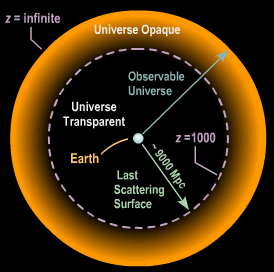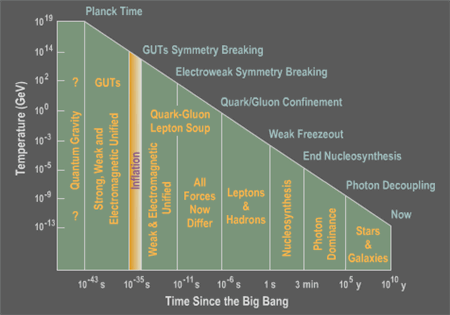|

(Science
Cartoons Plus)
The
Universe is expanding. This fact alone suggests
a starting point. But unlike circular expansion as
we know it, Astronomers abide by the cosmological
principle:
"Viewed on sufficiently large distance
scales, there are no preferred directions or
preferred places in the
Universe."
In other words, there is no known point of origin
of the Big Bang and the expansion of the
Universe is
relative to the observers position in the
Universe.
The more we learn about our
Universe, the more we
know the
Universe began from a single point of
energy some 13.6 billion years ago.
The most compelling evidence: The Cosmic
Background Radiation.

The
temperature of the Cosmic Background
Radiation is about 2 Kelvin. With such low
temperature, this effect is not the result of any
emission from stars or
galaxies. Think of compressed
gas - at its highest compression, the heat can
increase very rapidly. But release the gas and the
outer envelope cools rapidly - just like the Cosmic
Background Radiation (or CMB - Cosmic Microwave
Background Radiation).
 |
At a redshift of 1000 (z=1000),
decoupling occurred (around 300,000 years
after the Big Bang). Decoupling is just
another term for recombination when
electrons were bound up by protons.
The overall
temperature of the CMB is
2.735 Kelvin.
(Image credit: Brooks/Cole Thomson Learning) |
As an aside, the CMB is the only object in the
Universe that represents a near perfect black body
(a black body is a theoretical object that absorbs
all light that fall onto it - no no transmission or
reflection - any emission from the object will be
100% of all light that was absorbed). Black body
radiation is a term used to study the effects of
radiation from stars (and other things that emit
radiation).
To help understand the Big Bang, we first
identify the material involved:
Note that this includes matter and antimatter -
i.e. the
proton is positive and the
neutron is not;
the electron spins in one direction while the
positron spins in the other. For more information on
this, please take a look at the introduction to
Quantum Physics.
The timeline (note: we have no idea what happened
at exactly T=0 seconds)
- T = 1/1,000,000 seconds -
temperature is 10
trillion Kelvin - light elements form: photons,
quarks, neutrinos, electrons (no protons or
neutrons)
- T = 1/100 seconds -
temperature is 100
billion Kelvin - protons and neutrons form
- T = 1/10 seconds -
temperature is 50 billion
Kelvin - Neutrons less stable and convert back
to photons - 60% protons, 40% neutrons - protons
join to form deuterium, but unstable at high
temperature - deuterium bottleneck
- T = 1 second -
temperature is 10 billion
Kelvin - deuterium bottleneck still, now 75%
protons and 25% neutrons
- T = 14 seconds -
temperature is 4 billion
Kelvin - deuterium bottleneck still, now 82%
protons and 18% neutrons
- T = 3 minutes -
temperature now under 1
billion Kelvin - deuterium can form (2 protons
form nucleus), helium (4 protons) also forms
The first 3 minutes of the Big Bang resulted in
the nucleosynthesis of both hydrogen and helium -
without electrons. Also during this time the
temperature rapidly decreased while the expansion
rapidly increased.
Now for a more "slow" evolution:
- T = 35 minutes -
temperature is now 300
million Kelvin - temperature still to hot for
hydrogen and helium to bind electrons, increased
neutrinos and antineutrinos by positron
annihilation
- T = 1000 years -
temperature is now 100,000
Kelvin - bridge between radiation dominated and
matter dominated
Universe - Dark Energy
- T = 300,000 years -
temperature is now only
a few thousand Kelvin - recombination transition
- electrons can now bind with deuterium and
helium nucleus' -
Universe becomes transparent - CMB
Prior to T = 1000 years, radiation in the form of
photons and neutrinos dominated the
Universe.
Deuterium and helium nuclei were still forming but
electrons could not be bound. Prior to T = 300,000
years, the
Universe was opaque mainly because of the
dominate free electrons. Once the recombination
transition was reached, the
Universe became
transparent.

(Image credit: Brooks/Cole Thomson Learning)
Astronomers continue to study the
big bang by using tools like computer simulations of
dark
matter distribution and looking deep into the
early
Universe using the
Hubble Space Telescope.
Back to Top |

